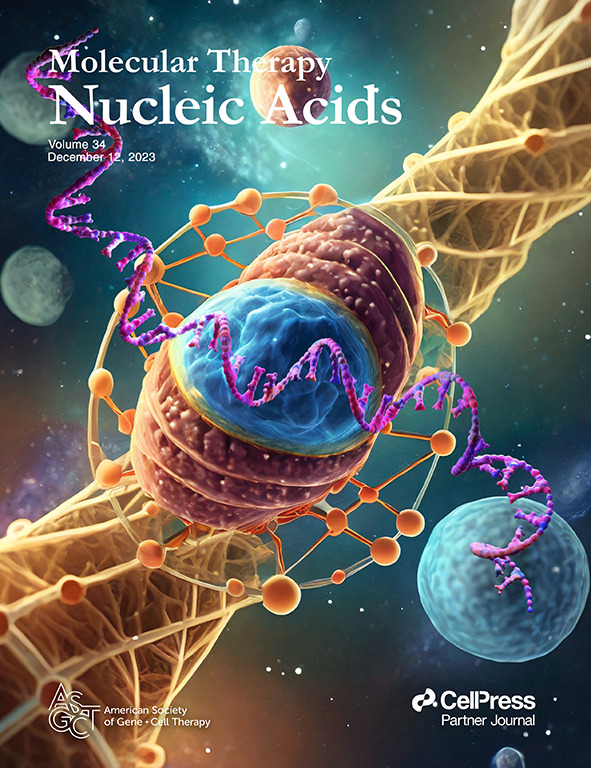高表达肌肉基因座中 RNA 引导 DNA 整合的精确性和有效性
IF 6.5
2区 医学
Q1 MEDICINE, RESEARCH & EXPERIMENTAL
引用次数: 0
摘要
基因替代疗法主要依靠腺相关病毒(AAV)载体进行转基因表达。然而,随着时间的推移,表观表达会因载体丢失或表观遗传沉默而下降。基于 CRISPR 的整合方法有望实现长期转基因插入。虽然转基因整合方法的开发已经取得了重大进展,但确定最佳插入位点仍具有挑战性。由于肌肉注射的低侵入性、肌肉占身体质量的相对比例、肌肉的多核性以及减少不良反应的潜力,骨骼肌是一种很有前景的基因替代组织。利用骨骼肌中的内源性启动子,我们评估了两个高表达基因位点,使用同源无关靶向整合(HITI)将报告基因或治疗基因整合到小鼠肌母细胞和骨骼肌组织中。我们通过共同释放 CRISPR-Cas9 和带有编码绿色荧光蛋白(GFP)或人类因子 IX(hFIX)的无启动子构建体的供体质粒,劫持了肌肉肌酸激酶()和肌红蛋白()的启动子。此外,我们还深入分析了靶向整合的基因组和转录组结果,并评估了拟议位点的安全性。这项研究介绍了在骨骼肌中实现高水平治疗基因表达的概念验证技术,有望应用于基于靶向整合的医学和合成生物学。本文章由计算机程序翻译,如有差异,请以英文原文为准。
Precision and efficacy of RNA-guided DNA integration in high-expressing muscle loci
Gene replacement therapies primarily rely on adeno-associated virus (AAV) vectors for transgene expression. However, episomal expression can decline over time due to vector loss or epigenetic silencing. CRISPR-based integration methods offer promise for long-term transgene insertion. While the development of transgene integration methods has made substantial progress, identifying optimal insertion loci remains challenging. Skeletal muscle is a promising tissue for gene replacement owing to low invasiveness of intramuscular injections, relative proportion of body mass, the multinucleated nature of muscle, and the potential for reduced adverse effects. Leveraging endogenous promoters in skeletal muscle, we evaluated two highly expressing loci using homology-independent targeted integration (HITI) to integrate reporter or therapeutic genes in mouse myoblasts and skeletal muscle tissue. We hijacked the muscle creatine kinase () and myoglobin () promoters by co-delivering CRISPR-Cas9 and a donor plasmid with promoterless constructs encoding green fluorescent protein (GFP) or human factor IX (hFIX). Additionally, we deeply profiled our genome and transcriptome outcomes from targeted integration and evaluated the safety of the proposed sites. This study introduces a proof-of-concept technology for achieving high-level therapeutic gene expression in skeletal muscle, with potential applications in targeted integration-based medicine and synthetic biology.
求助全文
通过发布文献求助,成功后即可免费获取论文全文。
去求助
来源期刊

Molecular Therapy. Nucleic Acids
MEDICINE, RESEARCH & EXPERIMENTAL-
CiteScore
15.40
自引率
1.10%
发文量
336
审稿时长
20 weeks
期刊介绍:
Molecular Therapy Nucleic Acids is an international, open-access journal that publishes high-quality research in nucleic-acid-based therapeutics to treat and correct genetic and acquired diseases. It is the official journal of the American Society of Gene & Cell Therapy and is built upon the success of Molecular Therapy. The journal focuses on gene- and oligonucleotide-based therapies and publishes peer-reviewed research, reviews, and commentaries. Its impact factor for 2022 is 8.8. The subject areas covered include the development of therapeutics based on nucleic acids and their derivatives, vector development for RNA-based therapeutics delivery, utilization of gene-modifying agents like Zn finger nucleases and triplex-forming oligonucleotides, pre-clinical target validation, safety and efficacy studies, and clinical trials.
 求助内容:
求助内容: 应助结果提醒方式:
应助结果提醒方式:


